If you want to create killer blues licks and channel the vibe of iconic blues guitarists like Albert King and Stevie Ray Vaughan, learning the Albert King Box is a great place to start.
As the name suggests, this is a box shape which Albert King used extensively in his playing. Just some of the many songs in which you can hear him solo using the box are as follows:
Stevie Ray Vaughan was heavily influenced by Albert King and went on to use the same box shape in his playing – most notably in songs like ‘Texas Flood‘, ‘Change It‘ and ‘Crossfire‘.
Even if these players don’t particularly resonate with you however, there are a wide number of benefits of utilising the box in your playing.
I will be covering these in more detail throughout this lesson and course. First though, let’s look at exactly what the Albert King Box is, and where you can find it on the fretboard:
What is the Albert King Box?
Many of the ‘box shapes’ that you encounter in the blues are simply groups of notes taken from a broader scale shape. It is no different with the Albert King Box.
The Albert King Box is simply a collection of 5 notes that appear in the second shape of the minor pentatonic scale.
This is what the Albert King Box looks like in the key of A:
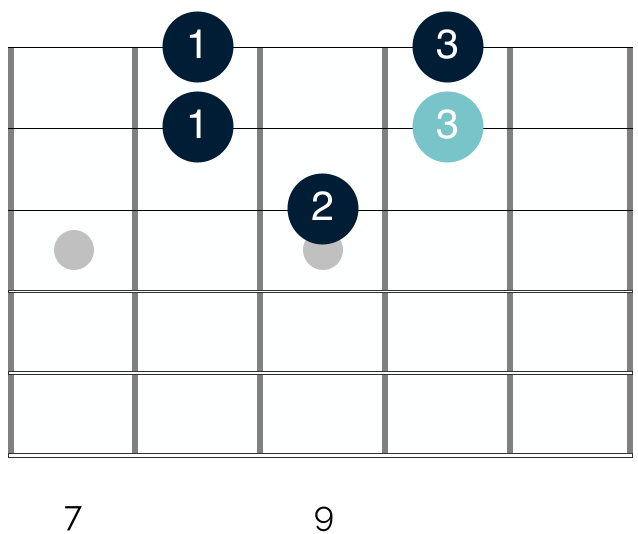
I have highlighted the tonic note of A in blue, and shown the suggested fingerings I recommend when playing in the shape.
I suggest using these because they allow you to target the notes of the box with your strongest fingers. This is important as this allows you to bend and solo in the box more freely.
I will cover this in more detail throughout the course, but first we can look at where these notes appear within the second shape of the minor pentatonic scale:

This diagram simply shows the second shape of the minor pentatonic scale in the key of A. This time I have not highlighted the tonic notes of A highlighted. Instead I have highlighted the notes of the Albert King Box in yellow.
It is important to note that this box shape is moveable. These 5 notes always appear in the second shape of the minor pentatonic scale. As such, you can move this shape around the fretboard to play the box in the key of B, C and D etc.
In the key of G for example, you will find the Albert King Box 2 frets lower than in the key of A, as follows:
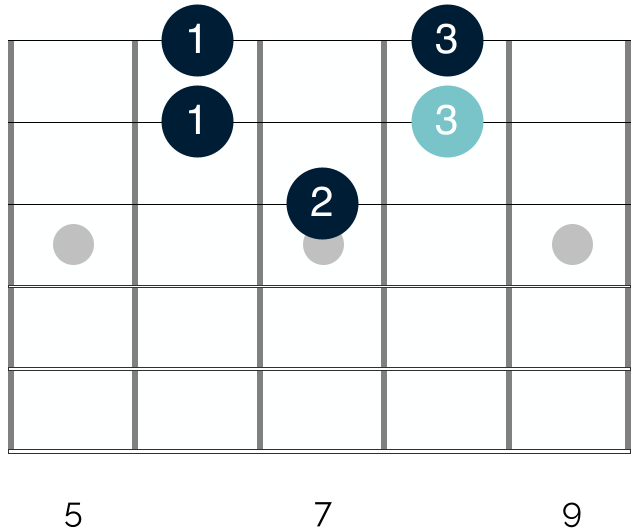
Conversely, in the key of B, you will find the Albert King Box 2 frets higher than in the key of A.
So you would start with your middle finger on the 11th fret of the G string, and play the 10th and the 12th frets on the B and E strings, respectively.
In this way, once you get comfortable with the box shape and how to craft licks and phrases using it, you can replicate these in a variety of different keys and musical contexts.
How to use the Albert King Box
The Albert King Box is so effective because it offers a wide variety of playing options within a compact section of the fretboard. I will explore these fully over the coming lessons of this course, but first it is worth understanding how you can target each of the notes of the box in your playing.
All of these examples are within the key of A, but you can apply these all over the fretboard; you just need to move them up or down into the relevant key.
G string 9th fret
This first note works very well as a launch note into the box, or as a way of resolving your phrases. I cover why this is the case later in this lesson with a discussion around intervals. In short though, it is partly because this note is challenging to bend effectively.
If you want to bend the note to reach the next note from the minor pentatonic, you have to push it up a tone and a half (3 frets). If you have the technical ability to do this, that is brilliant! Otherwise I’d use this note as a way of starting and finishing your phrases.
B string 8th fret
You can target this note in a whole variety of ways. You can bend the note across a variety of pitches – from a small blues curl up to a full tone bend that will push you up to the next note of the Albert King Box.
Additionally, you can think about moving between this note and the 10th fret of the B string with a variety of techniques like hammer ons and slides.
B string 10th fret
In the key of A, this is the tonic note of A. This makes it the perfect note to target at the end of your phrases to create a strong sense of resolution. You can also move between this note and the note at the 8th fret in a variety of different ways, including slides and pull offs.
Unless you have experience bending the tonic note, I don’t typically recommend that you try bending this note. This is because it typically creates a tense and dissonant sound (and not in a cool, bluesy kind of way!)
As such, work on finishing your licks on this note, and combining it with the other notes of the box using different techniques.
E string 8th fret
The 8th fret on the E string functions in much the same way as the 8th fret on the B string.
You can bend the note across a variety of pitches – from a small blues curl up to a full tone bend that will push you up to the next note of the Albert King Box. You can also target the note with techniques like slides, hammer ons and pull offs.
E string 10th fret
You have the same options at the 10th fret on the E string. This note doesn’t work quite so well with blues curls, but you can bend it either a semitone (in which case you will hit the blue note) or a full tone – up to the next note of the minor pentatonic.
You can also target the note with slides and pull offs as a way of moving between this note and the 8th fret on the same string.
Moving beyond the minor pentatonic scale
As you can hopefully see, the 5 notes of the Albert King Box offer you a huge amount of potential. However we can create even more options if we move beyond the minor pentatonic and add in 2 extra notes:
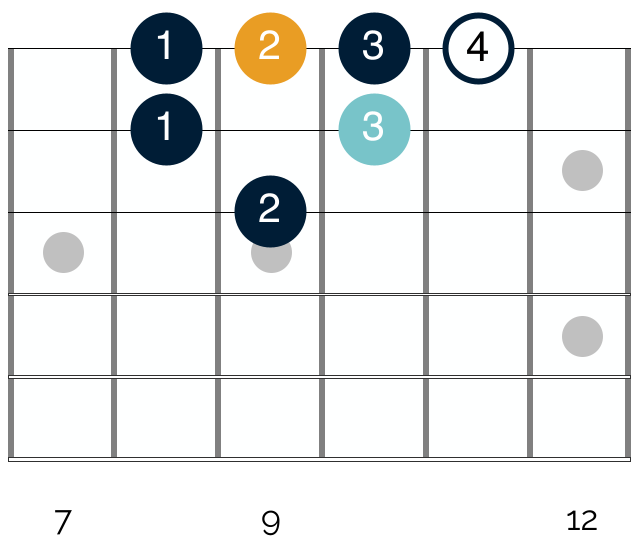
The first of these notes is from the major pentatonic scale and appears at the 9th fret on the E string. I have highlighted this in yellow on the diagram above.
The second is the blues note from the blues scale. This appears at the 11th fret on the E string and is shown in white in the diagram above.
As I explain from around the 9.50 minute mark in the video above, adding these notes into the box exponentially increases your options when soloing. You now have 4 notes in a row on the E string – all of which create a different feel in your playing.
When you target these notes with different techniques – and especially with bends – you can move between these notes and pull out their different flavours in a very smooth and dynamic way.
For example, if you bend the 10th fret on the E string a semitone, you will hit the blue note. This will add a tense and dissonant sound to your playing, which works very well when targeted intermittently.
Conversely, if you push the same note up to the 12th fret, you will reach the next note in the minor pentatonic scale. This will create a less dissonant sound and allow you to hold onto the bend for as long as you choose to do so.
I will explore some of these ideas in more detail in the later lessons of this course.
For now though, the key idea to appreciate is that there is a huge amount of potential in the Albert King Box – both in the ‘regular’ version of the box and in this expanded version.
Using techniques and especially bending will help you to realise this potential and transform your solos – allowing you to add some of that blues power magic!
Understanding intervals
Part of why the Albert King Box can work so effectively in your solos is because of the order of the notes in the box.
As noted earlier in this lesson, the box simply contains the 5 notes of the minor pentatonic scale. The way in which these notes are arranged however is notable and allows you to effectively manipulate tension and resolution in your playing.
To understand why this is the case, it is worth briefly discussing intervals.
To cover this topic in depth is beyond the scope of this lesson. If you would like to learn more though, just head over to the full course – An Introduction To Intervals.
For now though don’t worry – we won’t dive super deep into the theory.
Instead we will just cover some of the essentials to help you understand why the Albert King Box is so effective, and how you can target the notes of the box to craft a range of interesting blues licks.
If you are totally new to intervals, then they simply refer to the distance between notes. They also tell you the quality of any given note within a key.
For example, some intervals have a resolved and consonant sound, whilst others have a much more tense and dissonant sound.
The intervals in the minor pentatonic scales are as follows:
1 b3 4 5 b7
This is how they appear in the first shape of the A minor pentatonic scale:
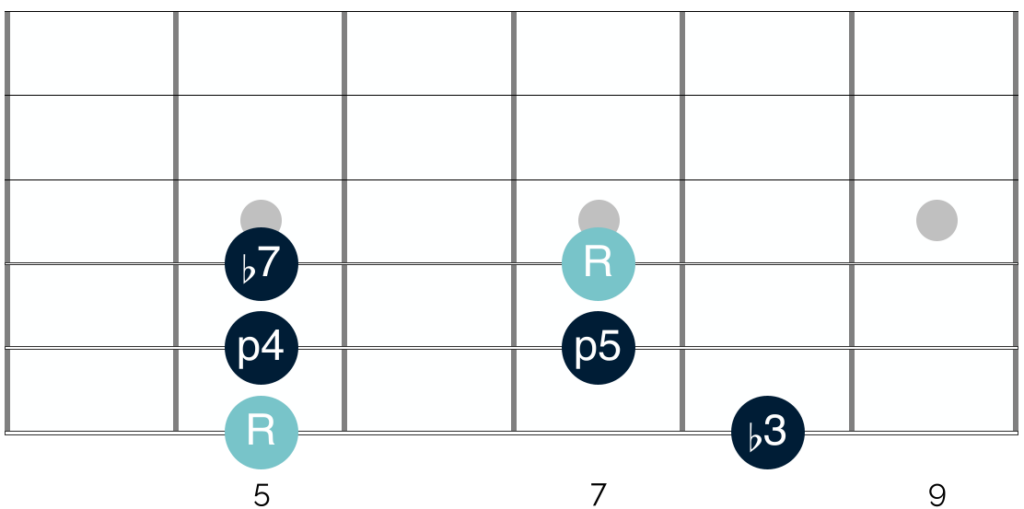
So you start on the tonic at the 5th fret on the low E string and then play the b3, 4, 5 and b7 from there.
The 1, 4 and 5 intervals are all ‘perfect’ in quality. This means that playing them creates a ‘perfectly’ consonant sound and a strong sense of musical resolution.
Conversely, the b3 and b7 are minor in quality. These give the minor pentatonic scale its minor tonality, and its more melancholic and edgy sound.
These intervals do not create a resolved and consonant sound. Rather, they allow you to create a tense and bluesy feel in your playing.
Both the b3 and b7 sit between perfect intervals in the minor pentatonic scale. The b3 is a tone and a half above the tonic and a tone below the perfect 4th.
Likewise, the b7 is a tone and a half above the perfect fifth and a tone (whole step) below the perfect tonic.
In this way, these intervals are brilliant to target with bends, slides, and hammer ons and pull offs. You can use them to create tension before resolving to one of the nearby intervals with a perfect quality.
Part of what makes the Albert King Box effective is the way that these intervals are ordered. This is as follows:
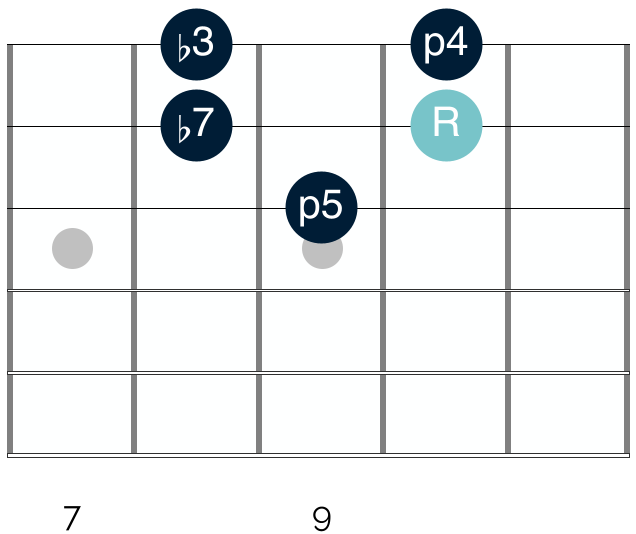
The ‘starting note’ of the box is the perfect fifth at the 9th fret on the G string, and the tonic note is at the 10th fret on the B string.
As noted above, the remaining 3 notes all lend themselves perfectly to string bending, as well as techniques likes slides, hammer ons and pull offs. In this way you can create and resolve tension quickly and fluidly in a very compact section of the fretboard.
Not only this, but the box shape lends itself well to targeting the 5th at the end of your phrases.
This is significant. Blues guitarists often target the tonic at the end of their phrases because of the very strong resolution it creates. I illustrate this at the 12.35 minute mark in the video above, with a series of ideas that are all based around the tonic.
However, targeting the 5th offers a great alternative and allows you to create more variety in your playing. You can see this in the following example in the video above, which I start at the 13.15 minute mark.
In that example I am soloing in the Albert King Box and focusing all of my ideas around the 5th. This creates quite a different feel in the licks and adds more variety to my playing.
Next steps
If you don’t yet feel confident to engage with this theory – or if you are finding it a little overwhelming – don’t worry!
At this stage the most important step you can take is to use the ideas I have outlined above to start playing and experimenting with the box shape.
As you do so, use your ear to guide you.
Listen to the impact that each note has within your licks, and how this changes when you target these notes with different techniques.
Get comfortable moving across the box and with starting and resolving your phrases in different positions.
Once you feel ready to do so, head over to the next set of lessons, where we will look at 3 practical ways you can target the box in your playing.
This will enable you to extract as much mileage from it as possible, and provide you with a series of frameworks you can target effectively in your solos. See you over there! 😁
